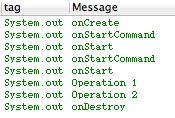Android中IntentService的原理及使用
在Android开发中,我们或许会碰到这么一种业务需求,一项任务分成几个子任务,子任务按顺序先后执行,子任务全部执行完后,这项任务才算成功。那么,利用几个子线程顺序执行是可以达到这个目的的,但是每个线程必须去手动控制,而且得在一个子线程执行完后,再开启另一个子线程。或者,全部放到一个线程中让其顺序执行。这样都可以做到,但是,如果这是一个后台任务,就得放到Service里面,由于Service和Activity是同级的,所以,要执行耗时任务,就得在Service里面开子线程来执行。那么,有没有一种简单的方法来处理这个过程呢,答案就是IntentService。
什么是IntentService,首先看看官方的解释:
IntentService is a base class forServices that handle asynchronous requests (expressed asIntents) on demand. Clients send requests throughstartService(Intent) calls; the service is started as needed, handles each Intent in turn using a worker thread, and stops itself when it runs out of work
还有一个说明是:
All requests are handled on a single worker thread -- they may take as long as necessary (and will not block the application's main loop), but only one request will be processed at a time.
大致意思是:所有请求都在一个单线程中,不会阻塞应用程序的主线程(UI Thread),同一时间只处理一个请求。那么,用IntentService有什么好处呢?首先,我们省去了在Service中手动开线程的麻烦,第二,当操作完成时,我们不用手动停止Service,第三,it's so easy to use!
ok,接下来让我们来看看如何使用,我写了一个Demo来模拟两个耗时操作,Operation1与Operation2,先执行1,2必须等1执行完才能执行:
新建工程,新建一个继承IntentService的类,我这里是IntentServiceDemo.java
public class IntentServiceDemo extends IntentService {
public IntentServiceDemo() {
//必须实现父类的构造方法
super("IntentServiceDemo");
}
@Override
public IBinder onBind(Intent intent) {
System.out.println("onBind");
return super.onBind(intent);
}
@Override
public void onCreate() {
System.out.println("onCreate");
super.onCreate();
}
@Override
public void onStart(Intent intent, int startId) {
System.out.println("onStart");
super.onStart(intent, startId);
}
@Override
public int onStartCommand(Intent intent, int flags, int startId) {
System.out.println("onStartCommand");
return super.onStartCommand(intent, flags, startId);
}
@Override
public void setIntentRedelivery(boolean enabled) {
super.setIntentRedelivery(enabled);
System.out.println("setIntentRedelivery");
}
@Override
protected void onHandleIntent(Intent intent) {
//Intent是从Activity发过来的,携带识别参数,根据参数不同执行不同的任务
String action = intent.getExtras().getString("param");
if (action.equals("oper1")) {
System.out.println("Operation1");
}else if (action.equals("oper2")) {
System.out.println("Operation2");
}
try {
Thread.sleep(2000);
} catch (InterruptedException e) {
e.printStackTrace();
}
}
@Override
public void onDestroy() {
System.out.println("onDestroy");
super.onDestroy();
}
}
我把生命周期方法全打印出来了,待会我们来看看它执行的过程是怎样的。接下来是Activity,在Activity中来启动IntentService:
public class TestActivity extends Activity {
/** Called when the activity is first created. */
@Override
public void onCreate(Bundle savedInstanceState) {
super.onCreate(savedInstanceState);
setContentView(R.layout.main);
//可以启动多次,每启动一次,就会新建一个work thread,但IntentService的实例始终只有一个
//Operation 1
Intent startServiceIntent = new Intent("com.test.intentservice");
Bundle bundle = new Bundle();
bundle.putString("param", "oper1");
startServiceIntent.putExtras(bundle);
startService(startServiceIntent);
//Operation 2
Intent startServiceIntent2 = new Intent("com.test.intentservice");
Bundle bundle2 = new Bundle();
bundle2.putString("param", "oper2");
startServiceIntent2.putExtras(bundle2);
startService(startServiceIntent2);
}
}
最后,别忘了配置Service,因为它继承于Service,所以,它还是一个Service,一定要配置,否则是不起作用的,开始我就是忘了,结果半天没反应。
<service android:name=".IntentServiceDemo">
<intent-filter >
<action android:name="com.test.intentservice"/>
</intent-filter>
</service>
ok,最后来看看执行结果:
从结果可以看到,onCreate方法只执行了一次,而onStartCommand和onStart方法执行了两次,开启了两个Work Thread,这就证实了之前所说的,启动多次,但IntentService的实例只有一个,这跟传统的Service是一样的。Operation1也是先于Operation2打印,并且我让两个操作间停顿了2s,最后是onDestroy销毁了IntentService。
这就是IntentService,一个方便我们处理业务流程的类,它是一个Service,但是比Service更智能。希望本文对大家有用,有任何建议或想法欢迎留言和我交流。
Demo源码下载
对Android&IOS感兴趣的朋友可以加入我们的讨论QQ群,在这里,我们只讨论干货:
iOS群:220223507
Android群:282552849
欢迎关注我的新浪微博和我交流:@唐韧_Ryan
